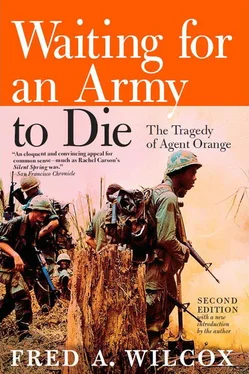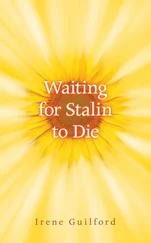It would be unfair, of course, to deny that there are dedicated doctors, nurses, administrators, and bureaucrats within the VA; but the agency’s failure to conduct an outreach program or to provide genetic counseling and family support services, and its refusal to begin an epidemiological study until ordered by Congress to do so (Public Law 96–151), have tarnished the VA’s reputation and posed serious questions about the protection Americans can expect from government agencies. Speaking of the VA’s denial of all disability claims based on Agent Orange, Senator Alan Cranston, chairman of the Senate Veterans’ Affairs Committee and floor manager of the bill signed into law by President Carter mandating the VA to conduct an epidemiological study, said: “The denial of almost all Agent Orange claims by the VA is viewed by some Vietnam veterans as suggestive that a deliberate cover-up or irresponsible action by the federal government is being carried out in much the same way as information about the adverse health effects from radiation was withheld from nuclear weapons test participants in the 1950s and 1960s.” 17
Yet even after Congress ordered the VA to begin an epidemiological study of Vietnam Veterans, the agency continued to exclude veterans and independent scientists from participating in the planning of the study. Before the actual study could begin, the VA needed to develop a design or protocol that would assure the study’s scientific objectivity and accuracy. (Although it did not have an epidemiologist on its staff, the VA planned to “contract out” only for the study design and to use its own personnel to conduct the study.) To secure a study design the VA developed a “request for proposals,” which it intended to send out to scientists who might be interested in participating. But at this stage the National Veterans Law Center confronted the VA once again, arguing that its “request for proposals” lacked scientific validity. “Examples of defects in to solicitation are legion,” said NVLC attorneys. “The proposal omitted important… data that would be necessary to develop a scientifically valid epidemiological study design, such as the facilities of the agency, the personnel to be used, the type of study population available for the study, the nature of access to the study population, or the funds available to gain access to the study population. The absence of this essential data is not typical of other government research proposals. Indeed, scientists who reviewed this proposal for the law center concluded that only a scientist with inside information about the study design could likely submit an acceptable proposed deisgn.” 18
Moreover, the “request for proposals” also stated that “anyone associated with a prior position regarding the effects of phenoxy herbicides and/or their constituents on human health” would be disqualified from bidding for the study design. This, said the VA, would assure that the study would be free of bias. By excluding anyone who may have published a paper or written an article on phenoxy herbicides, the VA was denying virtually all of the leading scientists in the field of dioxin research the chance to bid for the study. And while the exclusionary clause would keep highly qualified scientists from bidding for the study design, it did not prevent industry scientists or consultants from making a bid for the study. Consistent with its obstructionist position, the VA had devised just one more Catch-22 that hindered progress.
When the VA finally did award the contract for the epidemiological master plan, it was to a UCLA epidemiologist who would be quoted by the New York Times as telling a California assembly committee: “ ‘Agent Orange was used primarily in areas where few or no troops were located,’ and therefore, ‘the likelihood of substantial exposure to ground troops in Vietnam’ was not great.
“Dr. Spivey also told the panel that ‘there is to date little evidence’ of any specific human health effects’ as a result of the powerful herbicide. ‘The fear which is generated by current publicity is very likely to be the most serious consequences of the use of Agent Orange,’ he said.” 19
Two years after Congress ordered the VA to begin an epidemiological study of Vietnam veterans, Dr. Spivey submitted his protocol to the American scientific community and Congress’s Office of Technology Assessment. But the protocol was rejected by scientists and members of the OTA. After reviewing the protocol, John Sommers, deputy director of the American legion’s National Veterans’ Affairs and Rehabilitation Commission, said, “The design is incomplete and unacceptable as presently written. The authors are so obsessed with secrecy that information pertaining to diseases or symptoms if interest to the study and details relating to veterans they consider to be in a high or low exposure groups have been withheld.” 20 [12] For the American Legion’s August 24–26, 1982, resolution no. 410 (Iowa), “The American Legion Policy on Agent Orange,” see Appendix, 197–199.
Sommers also told a Senate Veterans’ Affairs Committee that even the protocol’s authors admitted that their work was incomplete because, said Sommers, “the investigators were denied access to certain classified military records because the VA failed to obtain a security clearance for the contractor or his assistants .” 21
Vernon Houk of the Center for Disease Control was also critical of the protocol. In fact, said Houk, the proposal “had such insufficient information that we did not indeed even classify this as a protocol.” 22Following the scientific review and comments from the OTA officials, the protocol was returned to UCLA for modifications. After twenty-four months, the epidemiological study was still mired in the planning stages.
The revised protocol was returned to the National Academy of Sciences for review, but even if the NAS had found the design acceptable it would have been years before the VA reached any conclusions on the health effects of Agent Orange. Although the agency said it was planning several new studies, including one of identical twins, one of whom served in Vietnam, officials continued to insist that the epidemiological study could not be finished until 1987. And while VA officials were searching for ways to improve the agency’s credulity among veterans, Illinois State Senator Karl Berning told a VA panel that he sensed “a lack of commitment, a lack of concern, a lack of interest on the part of the national government” regarding this issue. 23While conceding that studies may be necessary, Berning told the panel: “However, I remind you that while you and I are talking, men and women, our fellow citizens, are suffering and dying now—and, from what we have had in the way of testimony, with little or no help from their government.” 24
On March 3, 1982, four years after the VA first responded to Agent Orange claims, I asked Victor Yannacone, lawyer for the 2.5 million Vietnam veterans who are suing companies that manufacture Agent Orange, whether he had seen any change in the VA’s attitude in recent months. Yannacone had been cheerfully, almost endearingly bellicose during our interview, answering my questions with the candor and compassion that have won him the trust and respect of Vietnam veterans. But when I asked about the VA he paused, rose slowly from his chair, and, facing my tape recorder as though it were a jury, shouted: “Yes, the attitude has become militantly anti-Vietnam veteran. The management has become, if anything, more inept. And the trail of broken bodies and dying veterans is getting longer.”
On October 14, 1982, Robert P. Nimmo, who just a few days before had announced his resignation as VA director, informed reporters that the VA had decided to turn over its much-delayed and controversial study of the health effects of Agent Orange to the Center for Disease Control in Atlanta. While denying that the VA had intentionally stalled the study, Nimmo conceded that a “broad consensus” had developed to support the “belief that it would be in the best interests of veterans to have a non-VA scientific body conduct the Agent Orange epidemiological study.” 25Two weeks later the General Accounting office released a report that had taken its auditors two and a half years to complete. The report states that the VA did not actively attempt to locate and screen veterans suffering from symptoms potentially related to Agent Orange. It also chastises the VA for its inconsistent procedures at the agency’s 172 hospitals. In its rebuttal the VA argued that the GAO’s evidence was dated and that treatment at VA hospitals has improved considerably since the GAO’s auditor did his research.
Читать дальше











